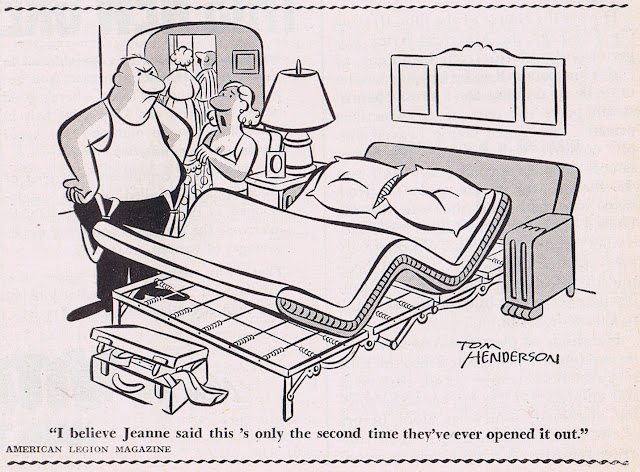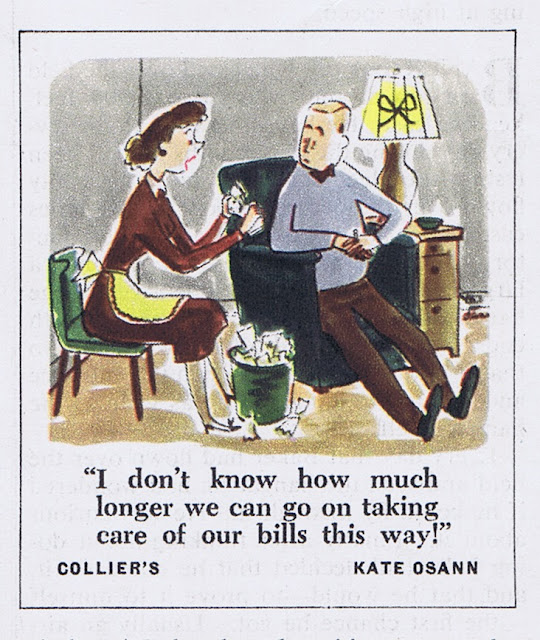The "door to door agnostics" cartoon was one that I liked. And that means that I thought it was funny and made an interesting point, you know? That did not mean it would sell. I had submitted to a number of markets with no success. When I submitted it to Prospect Magazine, the snagged it and ran it. Maybe it's the fact that they were rather fearless when it came to politics, religion and ideas was a factor in getting the OK. I don't know. But it made me happy, and reminded me once again that this is all about persistence.
Thursday, December 04, 2025
Mike Lynch Cartoon Religion Cartoon
Wednesday, December 03, 2025
Tuesday, December 02, 2025
Dick Buchanan's Gag Cartoon Heritage Consignment
More great gag cartoon originals are up for auction from Dick Buchanan's vast collection. Go and look. My goodness. There are some real terrific ones here by Barney Tobey, Dedini, Gahan Wilson, Punch magazine's Larry Reynolds, and Whitney Darrow, Jr. This auction ends tomorrow.
Monday, December 01, 2025
From the Dick Buchanan Files: Winter/Christmas/Holiday Gag Cartoons 1940s-60s
Hey, happy December 1st. And here is the first gift of the season: a batch of holiday-themed cartoons from my friend Dick Buchanan. He's found them and scanned them and now, here they are: seventeen little gag cartoon gems that may not have seen the light in decades.
Thanks so much, Dick.
---
GEORGE BOOTH. In 1953 Booth did monthly spot illustrations for the American Legion Magazine’s “Parting Shots” humor page. American Legion Magazine, December,1953 
PHIL INTERLANDI. Look Magazine, December 14, 1963
BEN ROTH. Ben was the elder of the four cartooning Roth brothers--Al Ross,
Irv Roir and Salo Roth. American Magazine, January, 1944
CHARLES PEARSON. The Saturday Evening Post, 1950’s.
DICK ERICSON. American Legion Magazine, December, 1952
ROBERT DAY. American Legion. December, 1953.
JAN & STAN BERENSTAIN. The Saturday Evening Post, 1950’s
VIRGIL PARTCH. True Magazine, December 1949
JEFF KEATE. American Magazine, January,1950.
ELDON DEDINI. Look Magazine, December 24, 1959
CHON DAY. The Saturday Evening Post, 1960’s
TOM HENDERSON. Then as Now Dept: Tom Henderson depicts the fate that befalls many a traveling relative during the holidays. American Legion Magazine, March,1953
BARNEY TOBEY. The Saturday Evening Post, 1950’s
FRITZ WILKINSON. The Saturday Evening Post,1950’s
TOM HUDSON. Did Hudson’s artificial snow seller spawn the waif hawking real snow by Charles Addams? (New Yorker, Jan 1, 1974) From Collier’s, December 21,1946
BARNEY TOBEY. Mr. Tobey again, confirming many suspicions. Look Magazine, December 24, 1959
JOSEPH MIRACHI. Look Magazine, December 31, 1963
-- Edited from a December 1, 2016 blog entry.
Monday, November 24, 2025
Live: New England Winter is Coming
It's a few days before Thanksgiving and things are a little busy here. In the mornings, I take a look at this"Boston and Maine" live webcam. Winter is coming. You can feel it in the air. At home, here in Northern New England, I've had the furnace cleaned and the woodstove has been pretty much in 24 hour mode the past week. It's time to hunker down. Have a wonderful Thanksgiving. I hope to see everyone in December.
Friday, November 21, 2025
More Original Gag Cartoons for Auction: Dick Buchanan's Heritage Consignment
There are some more great gag cartoon originals for auction at Heritage Auctions from my friend Dick Buchanan. This is a second batch, with more to come. Take a look and consider bidding. These are hard to find by some of the masters of 20th century magazine cartooning (Charles Rodrigues, Richard Decker, Frank Beaven, Claude Smith and Gahan Wilson). Here are a few screengrabs.
You can view and bid on his entire consignment #322548 at the following link: http://comics.ha.com/c/search.
Thursday, November 20, 2025
Unsold 1960 TV Pilot About Western Artist Charlie Russell Starring Fess Parker and Beverly Garland
Via WesternsontheWeb:
"'Russell' western TV series episode starring Fess Parker, Jay C. Flippen, Paul Carr and Beverly Garland. This is the pilot episode of a suggested TV series titled Russell from about 1960.
"... Borden Chase was hired in the early 1950s by United Artists to write a screenplay about Charles M. Russell's life. In July of 1955 United Artists announced Audie Murphy was to star as Charlie Russell. In a movie to be titled The Charles Russell Story. But the project was delayed and never happened. Then in the late 1950's or early 1960's Glenn Ford arrived in Montana scouting locations for the production and he was to star as Charlie. But again the production was stalled and never happened. So as another effort this pilot was made to try to produce a TV series about Charlie Russell. And again a production to be done about Charlie stalled out because the series was not picked up by a sponsor. So this episode never aired on television. This episode is a very fictitious story about Charlie and only has a few things in common with the real life Charles Marion Russell the Cowboy Artist. If you are interested in learning more about the Real Charles M. Russell there are several great books about the Cowboy Artist. The Charles M. Russell Book by Harold McCracken, Charles M. Russell by Frederic G. Renner, The 100 Best Illustrated Letters of Charles M. Russell by Brian W. Dippie, Charles M. Russell Printed Rarities from private collections by Larry Len Peterson, Romance Maker The Watercolors of Charles M. Russell by Rick Stewart and the Massive 400 page Charles M. Russell - Sculptor also by Rick Stewart which was a 5 year project for Rick and is an Amazing in depth look at the artists sculptor work. In this episode Charlie is very much in charge of things in real life Charlie was very young during his days as a cowboy and was called Kid Russell. But true to life Russell is a night herder. Also true to life Charlie draws his artwork on everything. Straying from reality to create excitement the episode makes Charlie a fast gun, Charlie was never known to be a fast gunfighter. But this is a fun enjoyable TV western episode from the most magnificent age of TV Westerns.
"The Forsaken Westerns series contains episodes of TV shows that were never broadcast or have not been broadcast in as many as 65 years. Almost lost forever, these rare television film treasures are now being released and uploaded for viewing from the Bob Terry's personal archive's of thousands of western films in his collection. Watch full length western movies and TV shows full episodes on the Westerns On The Web YT channel and make sure to subscribe to be notified when new videos are uploaded. The Forsaken Westerns is hosted by Bob Terry."
Wednesday, November 19, 2025
From the Dick Buchanan Files: Gag Cartoons in Color 1943 - 1957
Here are some great old timey gag cartoons from the major magazines
during the golden age of gag cartoons. These are some relatively rare
color cartoons that my friend Dick Buchanan has saved and clipped for us
to enjoy lo these many decades later.
Thanks and take it away, Dick!
--
GAG CARTOONS in COLOR
1943 – 1957
Gag cartoons were published in black and white. But several of the mass
circulation magazines, especially Collier’s, The Saturday Evening Post,
and Esquire published some cartoons in color. Many years have passed
and, somehow, a bunch of these aging cartoons wound up in the Cartoon
Clip File. Here, arranged almost completely at random are a few of
these color gag cartoons. Take a look . . .
1. MARTHA BLANCHARD. The Saturday Evening Post August 6, 1948.
2. REAMER KELLER. Collier’s March 31, 1951.
3. TED KEY. The Saturday Evening Post November 5, 1949.
4. CORKA. (Jon Cronin) Collier’s March 24, 1951.
5. HARRY LYONS. The Saturday Evening Post January 5, 1957.
6. JAN & STANLEY BERENSTAIN. The Saturday Evening Post July 24, 1948.
7. IRVING ROIR. Esquire February, 1952.
8. JOHN RUGE. The Saturday Evening Post April 18, 1959
9. JERRY MARCUS. The Saturday Evening Post June 22, 1957.
10. DAVID GERARD. Collier’s November 12, 1949.
11. ED NOFZIGER. The Saturday Evening Post December 10, 1949.
12. JERRY MARCUS. The Saturday Evening Post June 8, 1957.
13. KATE OSANN. Collier’s March 11, 1950.
14. FRANK BEAVEN. Collier’s August 14, 1943.
15. HANK KETCHAM. Collier’s March 31, 1951.
- From a blog entry of January 23, 2020
Tuesday, November 18, 2025
Dorothy Waugh's National Park Service Posters
Dorothy Waugh's 1924 passport photo.
Dorothy Waugh (1896 - 1996) was best known for creating a series of posters promoting national and state parks in the 1930s. Her graphics were influential in the early use of art by the National Park Service to promote public lands. Until the other day, I had not heard of Ms. Waugh. I wanted to share some of her graphics here.
Originally born in Vermont, her Dad was landscape architect. She would sit in on his classes at the University of Massachusetts, Amherst. She would study at the School of the Art Institute of Chicago, the Massachusetts School of Art, the Museum School of the Cleveland Museum of Art, the Ecole des Beaux Arts d'Orleans, the John Herron School of Art. and the Trenton School of Art.
Wikipedia:
"Conrad Wirth had studied with Waugh's father Frank while earning his Bachelor of Science degree in landscape gardening from Massachusetts Agricultural College (now the University of Massachusetts Amherst).[14] Wirth joined the National Park Service (NPS) in 1931.[15] With the coming of the New Deal, he supervised the service's Civilian Conservation Corps (CCC) program in the state parks. Many CCC participants could not interpret blueprints or the accompanying directives.[15] To address this he hired Dorothy Waugh in August 1933[15] to develop simplified diagrams and instructions for constructing basic park structures.[14] Waugh produced Portfolio of Comfort Stations and Privies (1934) and Portfolio of Park Structures and Facilities (1934).[16] During this time she also drew color illustrations for Recreational use of land in the United States: Part XI of the Report on land planning (1934).[1]
"Due to the scale and importance of this effort for the CCC, Waugh went from being the sole NPS employee working on the project to hiring and leading a team of male draftsmen. Additionally, the government hired architects to supervise the building projects who added their own drawings as needed.[17] This meant that her portfolios were followed by manuals in which Waugh had an advisory role, but no longer was contributing drawings.[1]
"In 1933, the Roosevelt administration designated 1934 as the 'National Parks Year.'[18] This allowed for a small budget to create a marketing campaign for the National Parks. Waugh designed posters for the campaign, although she was hampered by the small budget for materials that required her to execute her design on the first try.[19] By late summer of 1934, she had produced 'a set of six colorful posters depicting national park scenes.'[20][21] In 1935, Waugh produced another five posters, with recreation the theme for two, cultural heritage for two, and wildlife preservation for the fifth.[1]"






.png)




















.jpg)


















